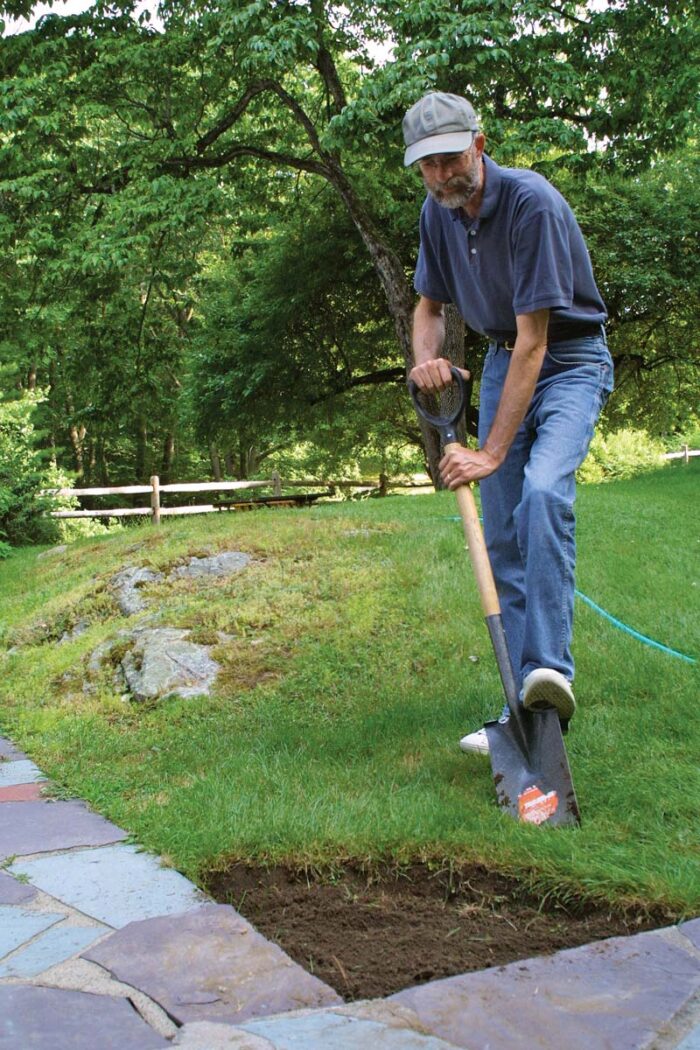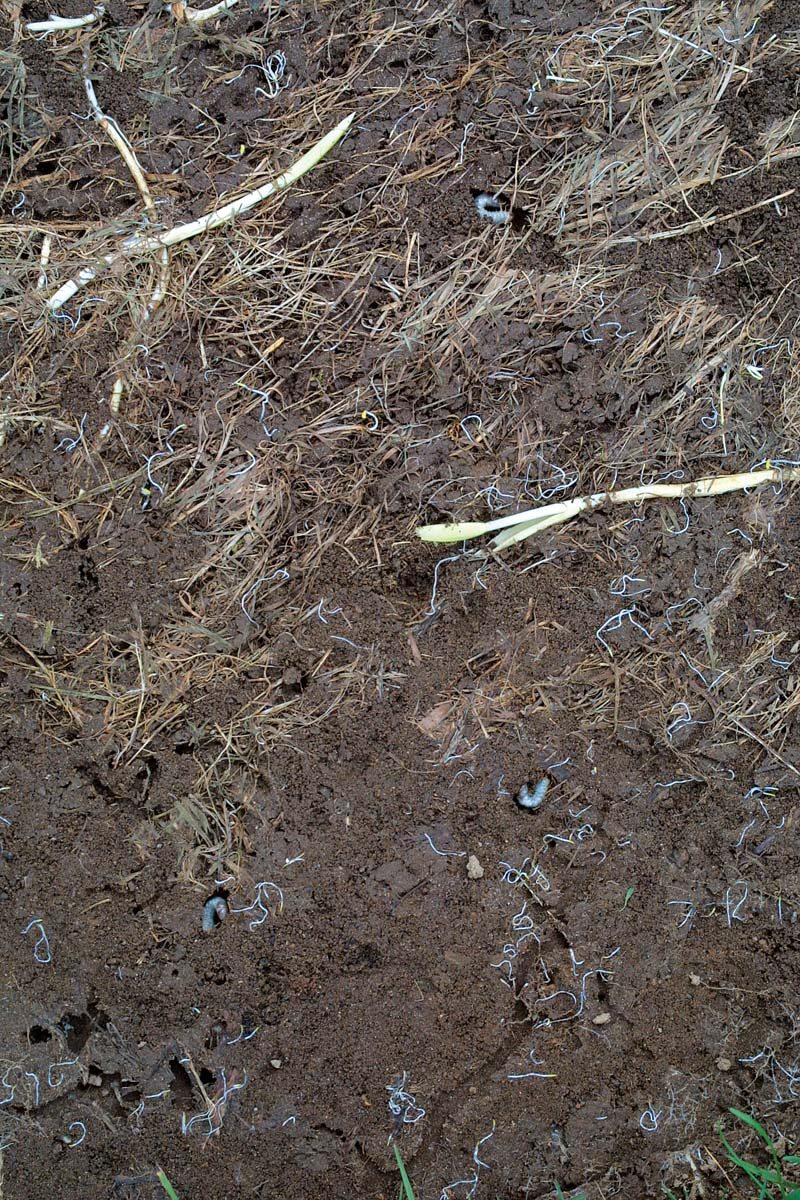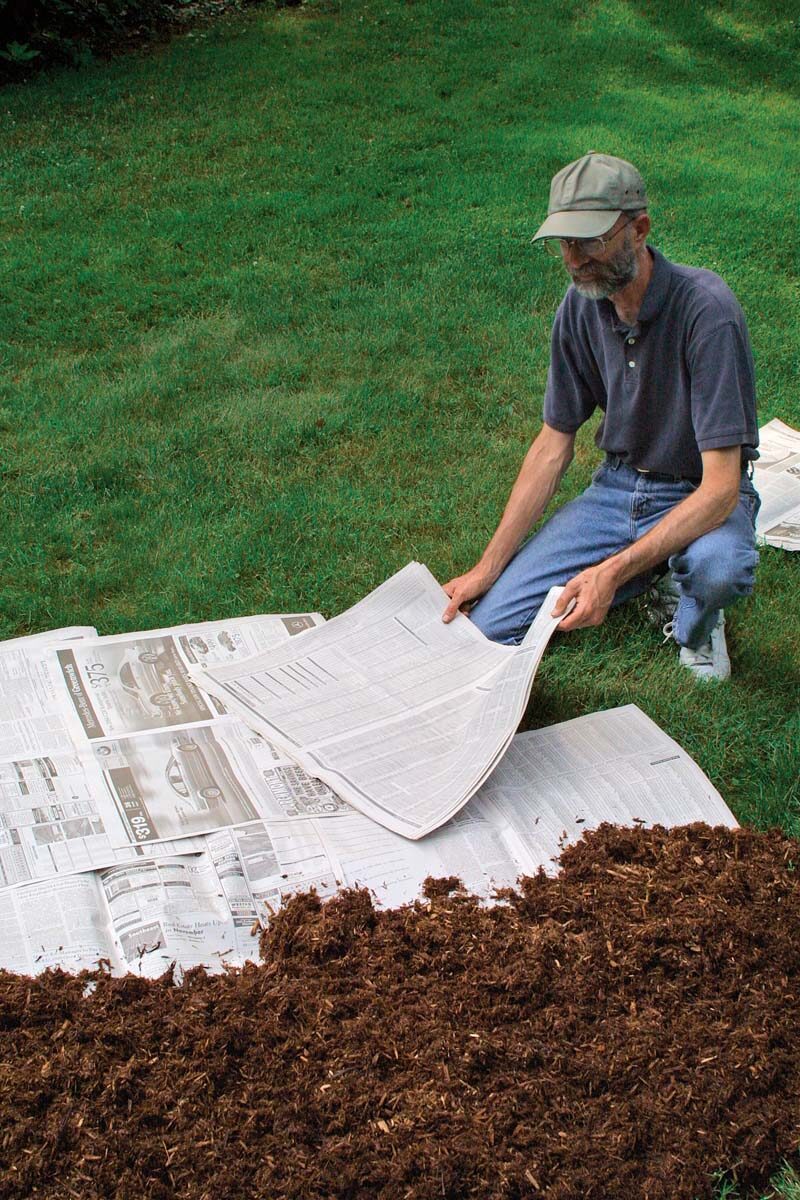4 Ways to Remove Sod
When starting a bed, choose the method that suits you best

If you are thinking about turning an area of lawn into a garden bed, your first step will be to get rid of the grass. You can take different routes to accomplish this: Those that yield quick results can require considerable effort, while less labor-intensive methods may take at least a season to produce results. Here are four techniques for turning well-established turf into a bed ready for planting. Each method has its pros and cons, but all will get you one step closer to the bed you’ve been dreaming of.
Learn more:
Low-Maintenance Alternatives to Lawns
1. Dig
This method produces quick, clean results and allows you to plant your garden immediately. But using a spade or fork to remove sod can result in a lot of sweat and sore muscles. If the sod is in good condition, you can use it elsewhere in your yard.
Water the area a few days ahead of time to make the soil easier to work. The soil should be moist but not soggy. Saturated soil is not only heavy but also susceptible to compaction, which leads to poor plant growth.
Cut the sod into parallel strips 1 foot wide using an edger or sharp spade. These strips can then be cut into 1- to 2-foot lengths, depending on the density of the turf and the thickness of the pieces. Next, pry up one end of a piece of sod and slide the spade or fork under it. Cut through any deep taproots, and lift out the precut piece, making sure to include the grass’s fibrous roots. If the underside of the sod contains much loose soil, a fork may work best, as this soil can be shaken back onto the surface when the sod is lifted.
Roll up the strips if you skip the crosscut step, and keep peeling the strip back. Keep in mind, though, that these rolls will be heavy. If you are installing a large bed, consider renting a sod cutter. These steel-bladed, plowlike tools are more efficient than spades for large jobs, and they come in human- and gas-powered models.
Inspect your new bed’s subsoil (and the underside of the sod if it will be reused). Once the sod is gone, look for and destroy potential pests, such as the larvae of May/June beetles. Remove any rocks, remaining clumps of grass, and sizable roots.
One drawback to sod removal is the significant loss of organic material, which greatly contributes to the health of plants. It must be restored as compost, as aged manure, or in some other form. Usually, topsoil must also be replaced. Some of it may be shaken out of the sod that was removed, but you will probably need more, especially if you need to raise the level of the bed.

| Pros: Permits immediate planting; avoids use of chemicals and loud power tools
|
Cons: Is labor intensive; exposes subsoil to weed seeds by eliminating vegetative cover; removes organic matter
|
Tip: Sharpen your tools before using them, and minimize muscle and joint strain by using ergonomically designed tools or tools of appropriate length and grip. |
2. Till
One advantage of tilling is that the original organic matter is retained in the garden as the sod is turned under. You can add organic matter by forking or shoveling compost, manure, grass clippings, or leaf mold onto the sod before tilling. Breaking up sod with a tiller requires some muscle, but most of the work is done by the tiller’s engine. Small tillers can usually handle previously worked gardens, but breaking up well-established sod requires a heavier, rear-tine unit and may require more than one pass. After tilling the bed, remove and shake the soil from any remaining clumps of grass.
A tilled bed can be planted immediately, but the process brings to the surface weed seeds that may germinate and cause problems later. You may also wind up inadvertently propagating some weeds like quack grass, which can send up new shoots from the small pieces of its chopped-up rhizome. Canada thistle does the same thing with its severed lateral roots. If you keep the soil moist and delay planting by a couple of weeks, you can pull, hoe, or otherwise dispatch these weeds as they emerge.

| Pros: Retains organic matter; is quicker and easier than digging; permits immediate planting
|
Cons: Is difficult on rocky sites and in wet or clay soils; turns up weed seeds; propagates certain weeds
|
Tip: Large tillers can be hard to maneuver. You will likely need to carve the edge of your new bed with a spade or edger, especially if the border is curved. |
3. Smother
Perhaps the easiest way to eliminate grass is to smother it using plastic, newspaper, or cardboard. Depending on the time of year and material used, this can take several months. Learn more: Watch how to build a new garden bed and smother weeds with sheet mulching.
Stretch light-excluding plastic over the lawn.
With the edges securely anchored, the temperature under the plastic will increase dramatically. The high temperatures and lack of light will eventually kill the grass, although they can also destroy beneficial organisms. Plastic can be covered for aesthetic purposes, but it isn’t biodegradable and should eventually be removed.
Lay cardboard or newspaper over the grass as a better alternative. Cover these biodegradable materials with grass clippings, leaf mold, mulch, or compost to hold the layers in place, keep in moisture, and add organic matter. Lay down six to eight sheets of newspaper; use paper printed with black-and-white ink only, as colored ink may contain heavy metals. Newspaper and cardboard do not increase temperature as much as plastic, but they eliminate light, causing chlorophyll to break down. Once this happens, photosynthesis stops and the smothered plants die.
You can plant right away if you’re using cardboard or newspaper. Just plug mature plants into holes that you have punched through the paper to the underlying soil.

| Pros: Does not require the physical effort of removing or turning under sod; leaves original organic matter in place; does not disrupt soil structure
|
Cons: Delays planting up to several months; may kill beneficial organisms if using plastic
|
Tip: Lay down newspaper layers during the summer, and wet them to help keep them in place. The following spring the grass should be dead, and much of the organic matter you’ve added will have been incorporated into the soil by earthworms and other organisms. |
4. Apply herbicides
I favor the first three methods, perhaps because I can see immediately any damage I cause (slicing through an earthworm with a spade, for example). Too often in our dealings with nature, unanticipated effects of chemical use have been discovered only later.
Choose an appropriate product, and carefully follow the directions on the label if you decide to use herbicides to kill your grass. Be sure to buy a product designed to kill grasses (not one specific to broad-leaved plants), and check the expiration date.
Don’t apply herbicides when rain is expected or they may wash off plants and into the soil and nearby waterways. Also, avoid applying on windy days to prevent drift onto nearby plantings. Wear protective clothing, such as gloves, long sleeves, long pants, and a mask when applying herbicides.
Well-established turf may require more than one application. It takes several days for effective absorption of herbicides. Grass and weed seeds in the soil will not be affected and may germinate later. This option may be reasonable if you have appropriate equipment and follow safety instructions and application recommendations carefully.
 |
 |
Herbicides kill grass quickly, but it’s often unclear what else they do in the soil. Some herbicides affect all plants, but others kill only grass, so choose wisely.
| Pros: Is relatively simple and quick for gardeners experienced in herbicide use; makes it easier to remove or turn grass
|
Cons: Risks injuring or killing nearby plants; can result in environmental contamination, personal injury, or harm to beneficial organisms when used improperly
|
Tip: Follow label directions carefully, including those for product storage and disposal. Use only products specifically formulated for the types of plants you want to kill. |





Comments
I'm puzzled by the author's recommendation to use methods 1 or 2, which seem much more likely to cause personal injury with their use of sharp mechanical implements and physical labor contrasted with the characterization that method 4 can cause personal injury. How so? Most of these chemicals have been studied for decades with no adverse effects found to the environment or the user when applied as recommended. I personally prefer method 3 but have had to resort to herbicides to eliminate Bermuda grass in California, sometimes its roots go down two or three feet.
I know! I see at least 20 articles a day, just in my town, of death by shovel! Physical labor is stupid anyway, just spray some chemicals on it. Am i right?
Too Funny!!!!!
I agree with Knot, (while laughing). Sure, and you rarely read about those thousands of people who die because they didn't bother with any physical type of work while watching TV.
I'm pretty sure methods 1 and 2 are encouraged because they allow a garden to be planted right away and serve a dual purpose in not only getting rid of the sod/grass/weeds on top, but also prepare the bed for planting, especially method 2. Methods 3 and 4 require weeks, possibly several, before the offending sod/grass/weeds are gone and once that is done you still have to prepare the bed itself for planting. Just an observation. Also, I'm not a fan whatsoever of spraying chemicals on the soil I plan to grow my food in. The main reason I have a garden is to give me and my family a healthy alternative to the chemical/insecticide laden food found in grocery stores. The bonus reasons for having a garden... way better tasting produce, far cheaper cost than store or farmer's market AND A GREAT WAY TO GET HEALTHY EXERCISE!!!!
Most chemicals have been studied by the companies that create the chemicals. Do you notice a bit of conflict? USDA depends on the reports by said companies or the "independent" companies that do testing (paid by the companies who create the chemicals) to decide "safety". Independent studies by outsiders are often impossible to do, due to proprietary law that protects the products of the companies or by trade secret laws or by copyright. In other words no one can test the products without express permission of the companies. If laws were different and anyone could test those chemical or the federal and state government actually did their own test, the we could by the "studied for decades with no adverse effects" you mention. I'm 68 years old, 5' tall, woman and I still do my own digging and pulling out. After letting the removed turf dry out upside down, shaking out as much soil as possible, I then transfer what is left to an area I have for long term composting with the roots facing up. Sound like a lot of work but I do grow most of what I eat. Larger areas I use my small electric tiller and then I cover the area with newspapers, topped with cardboard, which I then cover with compost. By the time the worms make it to the cardboard, which the love, I have great soil with not much work. If you believe you can trust the "studies" and have no problem growing in areas that you sprayed with chemical toxic enough to kill grass and other elements that are almost impossible to kill, go ahead. I guess I'm just "paranoid".
Husband says I don't need to remove grass on hill to plant shrubs Tec he says just to cover with weed suppressant then bark HELP
I recently turned 40 and the fact that my generation (and younger) have so blatantly ignored the tried and true (but labor intensive) methods of experienced and knowledgable gardeners such as yourself depresses me greatly. One need not look any further than the decimation of the bee population to observe the bone chilling effects that chemicals and GMO plant seed have wreaked upon our ecosystem! We have become a society where consumption outweighs production, rather than keeping a healthy balance of both... Eventually money will be the only green thing on the planet and that's heartbreaking to say the least!! Thank you for jumping at the opportunity to help educate and enlighten the ignorant and naive people who think the "studies" that have been conducted offer any unbiased results whatsoever! Our government has had us so preoccupied with the war on "street" drugs, that we didn't pay any attention to the truly epidemic use of chemicals that will devastate our planet, our ecosystem, and eventually us!! Oh, by the way, erring on the side of caution isn't being paranoid, if anything it's self preservation at the most basic level!!
What are you smoking
Those chemicals are not safe. They remain on the shelf only because they get sold and the corporations get a profit. Not because they are good for people, the earth, animals, or especially, bees. There are many groups trying diligently to get the government to declare them unsafe, just as other countries already have.
Best Way to Remove Grass: Give the teenager $20 down the street and have him do it for you.
That's what I did. Found a guy on Craigslist who was willing to dig the bed with a shovel.
Or you can rent a sod cutter. It slices out a 16” wide strip that you can just roll up and cut to manageable lengths.
The Sod Cutter is the most efficient GRASS REMOVAL METHOD. 1 day Rental = $80
Ain't that true
Lmfao I love this comment!!!!!
I think it is best to be to do these things - https://www.gardenloka.com/remove-rocks-from-yard/!
Good thing about living in Southern California with water restrictions, killed the grass over the summer. All I do is now is smother the remaining ones and continue to plant without grass.
I just got rid of a 100x50ft area of sod using a Brinly plow and a lawn mower. Just turn it over!
I refuse to use chemicals. They put enough round up in our food now, don't want more.
The whole point of a garden is to eat more healthy, not join the chemical companies in making us ill. I think I'll try the shovel method. We do have a rototiller, but grass comes up again if you just till it in. Good luck to everyone in their gardening. It's great when you do it right..........................................peggy
Spray dead before digging if it is a large area...
1) spray grass liberally
2) wait 2-3 weeks for death
3) dig out dead grass (much easier)
4) remove top soil with grass
5) apply new top soil to level (no organic mix or else yard will have lumps)
6) apply new sod
Log in or create an account to post a comment.
Sign up Log in